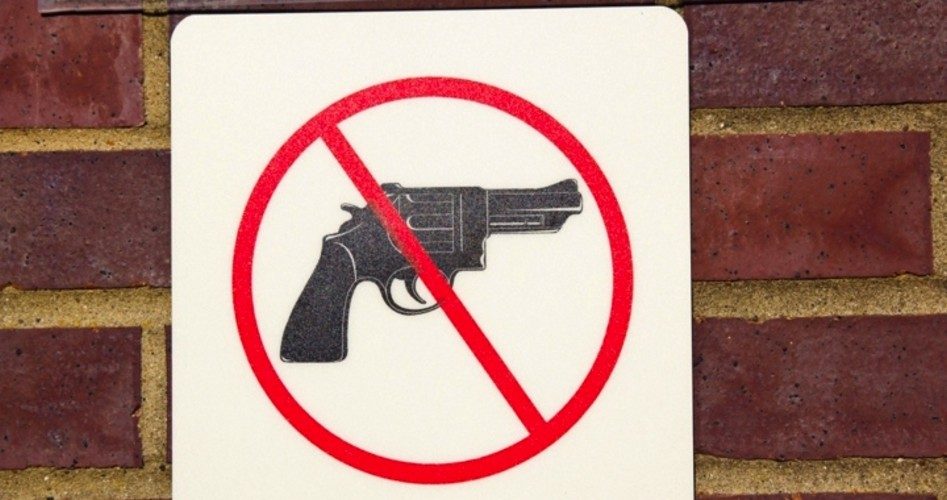
“I have but one lamp by which my feet are guided, and that is the lamp of experience. I know of no way of judging of the future but by the past.”
— Patrick Henry, March 23, 1775
A new book by Stephen P. Halbrook uses newly discovered secret documents from German archives, diaries, and newspapers from the time of the Weimar Republic and the Third Reich to demonstrate how civilian disarmament can be accomplished by “legal” methods.
In Gun Control in the Third Reich, Halbrook, a research fellow with the Independent Institute who has argued and won three constitutional law cases before the U.S. Supreme Court, “covers the [historic] periods of the Weimar Republic and the Third Reich leading up to World War II. The book then presents a panorama of pertinent events during World War II regarding the effects of the disarming policies. As Americans’ right to bear arms becomes increasingly challenged, it is a caution to all who debate these issues.”
Using his reading of what he calls an heretofore “hidden history,” Halbrook presents in a scholarly manner the story of how Hitler’s Nazi Germany used gun control legislation and executive orders “to disarm and repress its enemies and consolidate its power.”
As this reporter heard globalists admit while on assignment at the Arms Trade Treaty conference at UN headquarters in New York City in March, the Second Amendment is the last and greatest obstacle in the road that leads to civilian disarmament and the consolidation of exclusive control over guns and ammunition in the hands of government.
The Second Amendment to the Constitution declares, “A well regulated Militia being necessary to the security of a free State, the right of the people to keep and bear Arms shall not be infringed.” This right historically has been the right that protects all others. An armed populace is recognized as the most significant ally of liberty in its conflict with tyranny.
Like Patrick Henry, George Washington learned to rely on experience. Washington’s experience in the American War for Independence taught him the value of an armed populace in the shaking off of the chains of despotism. Washington said:
A free people ought not only to be armed and disciplined, but they should have sufficient arms and ammunition to maintain a status of independence from any who might attempt to abuse them, which would include their own government.
Not surprisingly, Adolf Hitler had a different take. The mastermind of the Third Reich said, “The most foolish mistake we could possibly make would be to allow the subject races to possess arms. History shows that all conquerors who have allowed their subject races to carry arms have prepared their own downfall by so doing.”
As Halbrook’s new book (and his recent interviews promoting it) demonstrates, a review of the gun control laws passed in Germany before and during Hitler’s reign of terror might serve as a cautionary tale for Americans of the 21st century.
If there are similarities between German disarmament laws that cleared the way for the seizure of absolute power by the Nazi party and contemporary American gun control proposals, they will become apparent to the reader, regardless of personal prejudices or predetermined outcome.
First, in 1919 (about nine years before the rise of the National Socialists), the German post-World War I government passed the Verordnung des Rates der Volksbeauftragen über Waffenbesitz (Regulations of the Council of the People’s Delegates on Weapons Possession). A reaction to the increasing presence of communists in Germany, this gun control law mandated, “All firearms, as well as all kinds of firearms ammunition, are to be surrendered immediately.” Anyone who was found in possession of a gun or ammunition could be punished by up to five years of imprisonment and a fine of 100,000 marks.
As agents of the German military enforced this law throughout Germany, in order to accelerate the seizure of all weapons and ammunition, the decision was made to install what might be called in modern political parlance a “Disarmament Czar.” Call for a gun control czar.
On August 7, 1920, the German government passed the Gesetz über die Entwaffnung der Bevölkerung (Law on the Disarmament of the People). This law created the office of Reichskommissar for Disarmament of the Civil Population. This official was tasked with making a list of “military weapons” that were subject to immediate seizure.
Perhaps the most frightening and foreboding provision of the law was that requiring all citizens with knowledge of anyone hoarding ammunition or who owned outlawed weapons to turn in to the Reichskommissar the names of these people. Neighbors spying on neighbors.
The next step in the complete disarmament of Germany prior to Hitler’s wresting of absolute power was the passage in 1928 of the Gesetz über Schußwaffen und Munition (Law on Firearms and Ammunition). This law required licensing of anyone who manufactured, assembled, or repaired firearms and ammunition. This included private citizens who reloaded their own rounds. Trade and sale of arms and ammunition was also forbidden without a license, including at gun shows and competitive shooting events.
The license to own a weapon provided for in the 1928 law was called a Waffenschein. This carry license was issued at the will of the government, and an applicant was required to show that his “reliability [was] not in doubt” and that he had a particular need for a firearm. Psychological testing for a gun license.
Further, this law placed caps on the types and numbers of weapons and ammunition that could be owned, even by those with licenses. Persons who owned more than five guns or more than 100 rounds of ammunition would have to seek a special license for such an “arsenal.” Caps on ammunition.
Progressive? The disarmament of the population certainly did progress rapidly. As Halbrook wrote in an extraordinarily thorough article published in 2000 in the Arizona Journal of International and Comparative Law:
Within a decade, Germany had gone from a brutal firearms seizure policy which, in times of unrest, entailed selective yet immediate execution for mere possession of a firearm, to a modern, comprehensive gun control law. Passed by a liberal republic, this law ensured that the police had records of all firearms acquisitions (or at least all lawful ones) and that the keeping and bearing of arms were subject to police approval. This firearms control regime was quite useful to the new government that came to power a half decade later.
On March 23, 1933, the Reichstag (German parliament) passed, by a vote of 441 to 94, a measure called the Enabling Act permitting Hitler to make laws without consulting the Reichstag. The president issuing decrees without consulting Congress.
Finally, within a week of assuming autocratic control of the lawmaking power in Germany, Hitler issued the following order regarding gun ownership:
The units of the national revolution, SA, SS, and Stahlhelm, offer every German man with a good reputation the opportunity to join their ranks for the fight. Therefore, whoever does not belong to one of these named units and nevertheless keeps his weapon without authorization or even hides it, must be viewed as an enemy of the national government and will be held responsible without hesitation and with the utmost severity.
And, in case there were any doubts about the seriousness of the severity, a newspaper entry announcing the edict informed citizens: “If we find military weapons or ammunition after 31 March 1933, we will be forced to proceed ruthlessly.”
This brief, irrefutable recitation of the “progress” of German gun control laws and executive orders seems to illuminate a more than incidental similarity between them and similar policies in the United States of the 20th and 21st centuries.
What does Halbrook say was the ultimate purpose and result of Hitler’s gun-grabbing laws and orders? In the new book, he writes:
By 1938, the Nazis had deprived Jews of the rights of citizenship and were ratcheting up measures to strip them of their assets — including the means to defend themselves. The horrific consequences have names etched in our consciousness: “The Night of Broken Glass” (Kristallnacht) and the Holocaust.
To order Stephen P. Halbrook’s important new work Gun Control in the Third Reich, click here.
Joe A. Wolverton, II, J.D. is a correspondent for The New American and travels frequently nationwide speaking on topics of nullification, the NDAA, and the surveillance state. He is the host of The New American Review radio show that is simulcast on YouTube every Monday. Follow him on Twitter @TNAJoeWolverton and he can be reached at [email protected]



